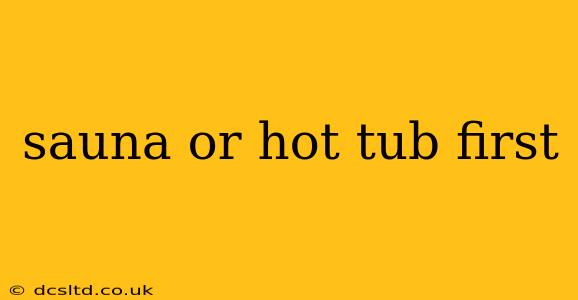Sauna or Hot Tub First: Deciphering the Ideal Order for Relaxation
Choosing between a sauna and a hot tub first is a question many relaxation enthusiasts grapple with. The answer, however, isn't a simple "one size fits all." The ideal order depends on your personal preferences, health conditions, and desired outcome from your spa session. This guide will help you navigate this decision, exploring the benefits of each and offering insights to guide your choice.
What are the benefits of a sauna?
Saunas offer a dry heat experience, typically ranging from 150°F to 195°F (66°C to 90°C). This dry heat promotes deep sweating, leading to detoxification and improved circulation. Many find saunas invigorating and energizing, making them a great option for a pre-workout warm-up or a midday pick-me-up. The intense heat can also help relieve muscle soreness and stiffness.
What are the benefits of a hot tub?
Hot tubs, on the other hand, offer a wet heat experience, typically between 100°F and 104°F (38°C and 40°C). The buoyancy of the water provides significant muscle relaxation and reduces joint pain. The combination of heat and massage from the jets can be particularly soothing after a long day or intense physical activity. Many find hot tubs more relaxing and calming than saunas.
Should I use the sauna before the hot tub?
Going from the sauna to the hot tub allows you to transition gradually from a higher temperature to a lower one. The intense heat of the sauna opens your pores, allowing for deeper cleansing and detoxification. Following this with the gentler heat of the hot tub can enhance the relaxation and muscle relief you experience. This sequence is generally preferred by those seeking deep detoxification and muscle relief. However, be mindful of dehydration; ensure you hydrate adequately between sessions.
Should I use the hot tub before the sauna?
Using the hot tub first can be a more gentle approach, especially for those sensitive to intense heat. The hot tub’s lower temperature prepares your body for the higher temperature of the sauna, potentially making the transition smoother and more comfortable. This order is often better for individuals with cardiovascular issues or those new to heat therapy. The buoyancy of the water may also help to alleviate any muscle soreness before you subject your body to the intense heat of the sauna.
Which is better for muscle recovery?
Both saunas and hot tubs contribute to muscle recovery, but in slightly different ways. The intense heat of the sauna improves circulation and can help to flush out metabolic waste products, while the buoyant environment and jets of the hot tub offer targeted muscle relaxation and pain relief. For optimal muscle recovery, alternating between the two can be highly effective. Consider the sauna for deeper muscle penetration and the hot tub for focused relaxation and pain reduction.
Is it better to cool down between sauna and hot tub sessions?
Yes, absolutely! Cooling down between sauna and hot tub sessions is crucial for your safety and well-being. Taking a cool shower or simply resting in between helps to regulate your body temperature and prevent overheating. Dehydration is another risk, so drinking plenty of water is vital. Never rush the cooling-down process. Listen to your body and take breaks when needed.
How long should I spend in each?
The ideal duration in a sauna or hot tub depends on your tolerance and individual health conditions. For saunas, 15-20 minutes is usually recommended, while for hot tubs, 15-30 minutes is typical. Always listen to your body and exit if you feel uncomfortable or dizzy.
In conclusion, the "sauna or hot tub first" question has no definitive answer. The best approach depends entirely on your personal preferences, health conditions, and intended relaxation goals. Experiment with different orders to determine what works best for you and always prioritize your safety and well-being. Remember to stay hydrated and cool down appropriately between sessions.
